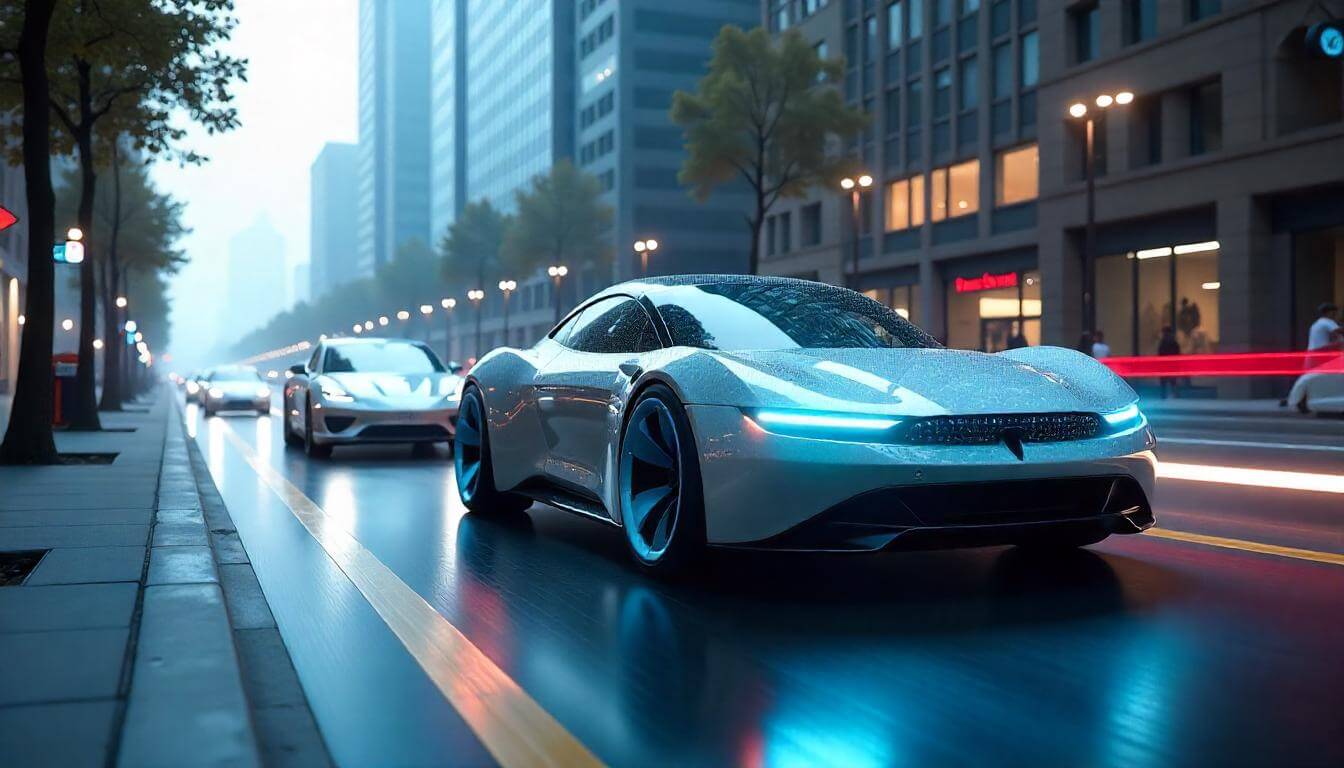The automotive industry in 2025 is experiencing a technology boom, offering solutions that make driving safer, more comfortable and greener. Innovations in 2025 vehicles include advanced artificial intelligence systems, new approaches to safety and energy efficiency that are changing the way we think about transport. From smart interfaces to hybrid powertrains, these innovations are already shaping the future of roads. In this article, I'll break down five key technologies that will dominate the automotive industry in 2025 and explain how they will affect drivers.
Improved autonomous driving systems
Autonomous driving continues to be one of the most talked about topics in the automotive industry. In 2025, autopilot technology has taken a significant step forward, bringing us closer to full automation.
Progress in the level of autonomy
Most of the new 2025 models are equipped with SAE Level 2 and 3 autonomy systems, allowing the driver to temporarily take his or her mind off driving on motorways [web:2]. For example, the Mercedes-Benz S-Class with Drive Pilot can now autonomously navigate traffic jams and motorways, using lidar and neural networks to analyse its surroundings [web:10]. Also, companies like Waymo are expanding Level 4 test zones, where the car drives without human intervention in certain conditions [web:10]. The bottom line is that these technologies reduce driver stress and increase safety.
Artificial intelligence behind the wheel
AI has become the heart of autopilots, processing data from cameras, radar and 5G networks in real time [web:11]. For example, Tesla Cybercab uses neural networks to predict the behaviour of pedestrians and other cars, reducing the risk of accidents [web:10]. However, the systems still face challenges in challenging weather conditions such as heavy rain or snow [web:2]. In addition, AI training requires huge amounts of data, which raises privacy issues [web:20]. Thus, autonomous driving is getting smarter, but is not yet ready to fully replace humans.
Ultra-circular cameras
Visibility technologies have reached a new level in 2025, making parking and driving off-road easier and safer.
A 540-degree view
Cameras with a 540-degree view, introduced back in 2023, have become standard on many 2025 crossovers, such as the Hyundai Santa Fe and Jetour T2 [web:8][web:5]. These systems show not only the vehicle's surroundings, but also the space under the underbody, which is especially useful on rough terrain [web:4]. For example, the driver can see rocks or potholes under the wheels, avoiding battery damage in electric cars [web:0]. Also, such cameras help when manoeuvring in tight urban spaces [web:8]. In summary, super-circular visibility increases confidence behind the wheel.
Integration with AI
The cameras now work in conjunction with AI, which recognises obstacles and warns the driver of possible collisions [web:5]. For example, the system in LADA Iskra uses 5 cameras and 14 radars to create a 3D model of the environment, helping novices park without stress [web:1]. However, stickers or dirt on the cameras can reduce their effectiveness, so manufacturers are adding self-cleaning systems [web:0]. On top of that, camera data is transferred to the cloud to improve algorithms, which requires a reliable 5G connection [web:11]. Thus, visibility technologies make driving more intuitive.
Hybrid powertrains
Green technology remains at the forefront of carmakers' minds, with hybrids becoming more popular than electric cars in 2025 due to their versatility.
New hybrid engines
Many 2025 models, such as the Toyota RAV4 and Tank 500 PHEV, feature hybrid powertrains combining a petrol engine with an electric motor [web:7][web:5]. For example, the RAV4 with BYD's new 1.5-litre hybrid produces up to 200 hp and consumes just 5 litres per 100 km [web:7]. Hybrids such as the Volga C40 also offer a range of up to 800km, solving the problem of Russia's limited charging network [web:14]. In summary, hybrids appeal to those who want to save fuel without compromise.
Benefits and Challenges
Hybrid systems reduce CO2 emissions by 20-30% compared to conventional internal combustion engines, which fulfils the stricter Euro-7 environmental regulations [web:7]. However, they are more expensive to manufacture and more difficult to repair due to their dual construction [web:5]. For example, replacing the battery in a Tank 500 PHEV can cost up to 300,000 rubles [web:5]. In addition, hybrids require quality fuel, which can be a problem in regions [web:0]. Thus, hybrids are a bridge between internal combustion engines and electric cars, but with certain limitations.
Driver monitoring systems
Innovations in 2025 cars are emphasising safety and driver monitoring systems are becoming a must-have feature in many models.
How it works
Systems developed by companies such as Harman use cameras and sensors to analyse the driver's heart rate, breathing and eye movements [web:8]. For example, in the Kia EV3, winner of World Car of the Year 2025, AI detects fatigue and suggests a route change or pause [web:15]. If the driver doesn't respond, the system can automatically reduce speed or activate emergency signals [web:8]. Also, these technologies help detect intoxication, reducing the risk of accidents [web:18]. The bottom line is that monitoring makes roads safer.
Regulation and privacy
In Europe, such systems have been mandatory for new models since 2024, and Russia plans to introduce similar requirements by 2027 [web:8]. However, the collection of biometric data raises privacy concerns - drivers fear that the information could be shared with third parties [web:20]. Manufacturers such as Hyundai promise to store data locally, but this requires strict cybersecurity standards [web:5]. In addition, the systems sometimes give false positives, such as reacting to sunglasses [web:8]. Thus, the technology is promising, but needs to be further developed.
Smart multimedia systems
Modern cars increasingly resemble smartphones, and multimedia systems are becoming the centre of driver-machine interaction in 2025.
Personalisation and AI
Multimedia in models such as the BYD Seagull and Volkswagen ID. Buzz, uses AI to customise the interface to the driver's habits [web:15]. For example, the system in the BYD remembers favourite radio stations, adjusts the climate control and suggests routes based on traffic [web:5]. Also, voice assistants like Grok understand natural speech and can answer questions like "Where's the nearest charger?" [web:20]. [web:20]. As a result, driving becomes more comfortable and intuitive.
Over-the-air updates
Automakers are moving to modular software architectures that allow for system updates without a service visit [web:2]. For example, the Tesla Model Y in 2025 received Audio Magic Eraser, a feature that improves interior sound, via an OTA update [web:10]. However, reliance on the internet creates risks - without a 5G connection, some features may not be available [web:11]. On top of that, subscriptions to premium features, such as enhanced autopilot, cost 5,000-10,000 rubles per year [web:2]. Thus, smart systems add convenience but incur costs.
Impact of innovations on the Russian market
The Russian market in 2025 is actively adapting to global trends, but faces unique challenges.
Affordable models with new technologies
Models such as the LADA Iskra and Volga C40 offer access to innovations at prices starting from 1 million roubles [web:14]. For example, the Iskra is equipped with review cameras and basic Level 2 autopilot, making it competitive even with Chinese brands [web:1]. Also, Chinese crossovers such as the Jetour T1 bring hybrid technology and smart multimedia at prices as low as RUB 2 million [web:5]. As a result, innovations are becoming more affordable for Russian drivers.
Challenges of implementation
Limited 5G network and charging stations slow down the adoption of some technologies, especially in the regions [web:11]. For example, hybrids are more popular than electric cars due to weak infrastructure - there are only about 3,000 charging stations in Russia versus 50,000 in China [web:5]. Also, high import duties on electronics increase the cost of cars with advanced systems [web:7]. On top of that, localising production like Volga takes time and investment [web:14]. Thus, Russia is moving towards innovation, but with a delay.
Bottom line: innovations in the cars of 2025 are changing the driving experience
Car innovations for 2025 are setting new standards for the automotive industry, offering drivers more safety, comfort and environmental friendliness. Autonomous driving, ultra-circular cameras, hybrid engines, driver monitoring systems and smart multimedia are already available in production models. In Russia, these technologies are appearing in cars such as the LADA Iskra and Jetour T1, despite infrastructure constraints. By 2030, the market could move to level four autonomy and mass-market electric cars if infrastructure catches up with progress. Ultimately, 2025 is a watershed year for the automotive industry, opening the door to the future of transport.

 Top 5 innovations in cars of 2025">
Top 5 innovations in cars of 2025">
